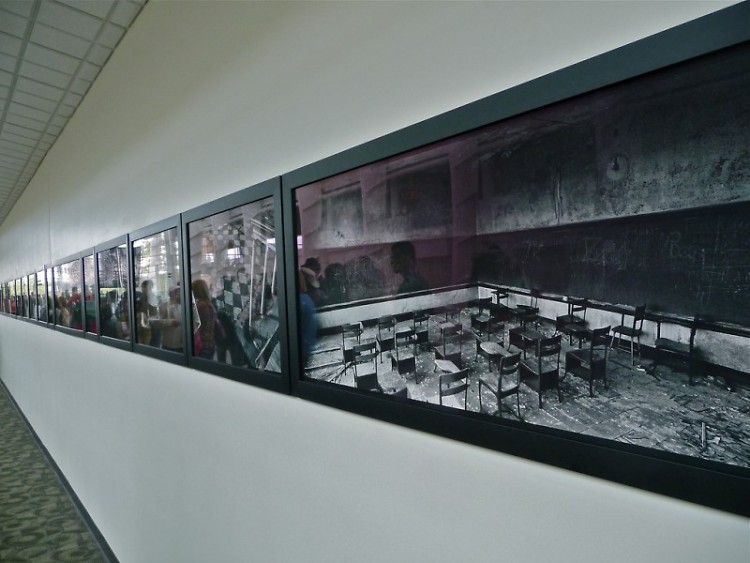The philosopher William James once wrote that it is important to ask not what reality is, but “under what circumstances do we think things are real?” That question came to mind when viewing Ludington artist Ryan Spencer Reed’s photographic suite “Detroit Forsaken.” The piece, which consists of a series of photographs of Detroit ruins, is haunting and well executed. But it is also problematic — not for what aspects of reality are present but for what is conspicuously absent.
I walked into DeVos Place on my quest to see all of the pieces in the top 10 when I stumbled upon Reed’s piece. As a longtime Detroitophile, the images of crumbling façades and eerily empty spaces were familiar. Photographing Detroit’s urban decay has long been a popular sport for a certain cadre of urban spelunkers. Digital artist Lowell Boileau’s “Fabulous Ruins of Detroit” website, launched in 1996, was an early and successful use of the web to create an interactive work of conceptual art. But along with images of nature’s reclamation of empty structures, Boileau created an active online community that engages in the painful dialogue between disparate members of the Detroit diaspora — those who still live there, and those whose Detroit exists only in fond memories of Hudson’s and rides on the Bob-Lo boat.
But unlike Boileau’s work, Reed’s photographs suffer from a lack of humanity. “Nearly devoid of the human form, these images capture the aftermath of unsustainable business practices,” he wrote in his artist statement. In a conversation, Reed told me that his work critiques America’s “misspent youth,” which he described as the rampant and unsustainable consumerism and lack of leadership and vision in the post WWII world. But by focusing on the economic and industrial angle, Reed neglects both the human toll and the human aspirations of Detroiters (that’s not a critique that can be leveled at the artist’s work in Darfur, by the way. Those images are filled with compassion and empathy).
The real consequence of the lack of humanity in Reed’s Detroit work, though, played out in the discourse of the people walking by. Standing there and listening in, one heard wistful memories and disgust over the demise of the Detroit of yesteryear, but little concern about the 875,000 people who are still there. The work seemed to fetishize artifacts from the past like the Michigan Central Depot or Tiger Stadium while ignoring the flesh-and-blood Detroiters who believe in the city’s motto of "Speramus Meliora; Resurget Cineribus" (“We hope for better things, it will rise from the ashes”).
Reed said several times that his intention was not to kick a city while it’s down, and there’s no reason to question that intention. However, it is completely reasonable to question whether the effect of the work does just that. The depopulation of Detroit and the abandoned buildings that phenomenon brought with it is real, but it is not the only story that there is to tell. However, it is the tired old story that Reed chose to retell.
Does an artist have a responsibility for the discourse his or her art inspires? I would suggest that when an artist creates a work as political as Reed’s, the answer is yes. Yet, unfortunately, that is a responsibility the artist shrugs off.
I'm not naive here -- Detroit has challenges, and some of Reed's critiques may have value. But in the 1970s, Emily T. Gail launched a campaign to encourage people to "Say Nice Things About Detroit." That doesn't seem like such a bad idea here.
The Rapidian, a program of the 501(c)3 nonprofit Community Media Center, relies on the community’s support to help cover the cost of training reporters and publishing content.
We need your help.
If each of our readers and content creators who values this community platform help support its creation and maintenance, The Rapidian can continue to educate and facilitate a conversation around issues for years to come.
Please support The Rapidian and make a contribution today.


Comments
I thought the article "Detroit Arcadia" by the brilliant Rebecca Solnit tackled the aspirations and possibilities of the people who have stayed in Detroit.
I think that is one of the best pieces I have read about Detroit because it seems to focus on the future and the potential for the city to reinvent itself as "the first Post-American city".
Great stuff. I hope you continue to contribute to the Rapidian.
This was only one of several, including "Icehouse". The version I found most interesting was that of Kevin Bauer's at Fountain Street Church, "100 Abandonned Houses." These images isolated specific houses in a 5x5 image. The invitation was to look at the specific house, even as the parts add to a summed understanding (a common theme in AP, including the winner with its refracting of personality over multiple portraits). The isolation of the houses also moved beyond the sentimentality of loss that seemed to be the subject of "Detroit Forsaken."
As to the portrayal of Wrecked Detroit, the locals often capture a far more biting set of images.
It does seem to be the case in W Michigan, that we like our Detroit dystopia, not least for the moral superiority it supposedly conveys. The same dystopic vision has its own politics, as well: the "let's not be like Detroit" becomes the routine roadblock to questions of our own urban problems.